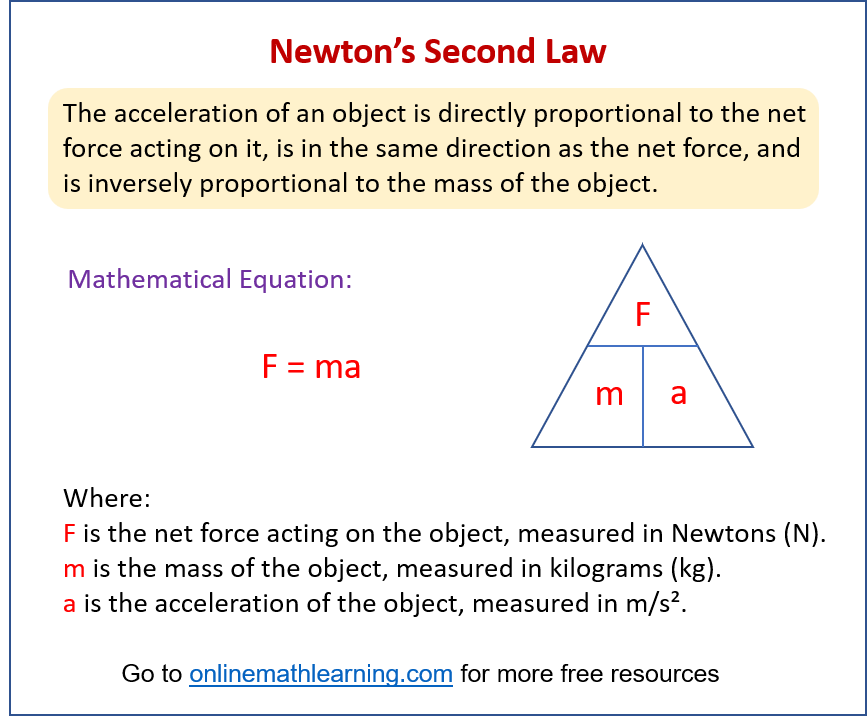Newton's Second Law Experiment: Physics Required Practical
Newton’s Laws of Motion
Sir Isaac Newton’s three laws of motion are fundamental principles of classical physics that describe the relationship between a body and the forces acting upon it, and its motion in response to those forces.
- Newton’s First Law of Motion (Law of Inertia)
- Newton’s Second Law of Motion (Law of Acceleration)
- Newton’s Third Law of Motion (Law of Action and Reaction)
In this lesson, we will look at the experiments/practicals to illustrate Newton’s Second Law.
The following diagram gives the Newton’s Second Law of Motion. Scroll down the page for more examples.

Newton’s Second Law of Motion (Law of Acceleration)
Statement: “The acceleration of an object is directly proportional to the net force acting on it, is in the same direction as the net force, and is inversely proportional to the mass of the object."
Mathematical Formula: This law is expressed by the equation:
F = ma
Where:
F is the net force (the vector sum of all forces acting on the object), measured in Newtons (N).
m is the mass of the object, measured in kilograms (kg).
a is the acceleration of the object, measured in meters per second squared (m/s²).
Newton’s Second Law: GCSE Physics Required Practicals
How are force, mass and acceleration related?
F = ma
In this practical you will:
- time how long it takes for a toy car or trolley of constant mass to move a distance when different forces are applied to it
- time how long it takes for a toy car or trolley to move a distance if the force applied is constant but the mass of the toy car or trolley is varied
- calculate the acceleration of the toy car or trolley in each case.
Activity 1: Measuring the effect of force on acceleration at constant mass
Method
- Use the ruler to measure intervals on the bench and draw straight lines or place tape across the bench at these intervals.
- Attach the bench pulley to the end of the bench.
- Tie a length of string to the toy car or trolley. Pass the string over the pulley and attach the weight stack to the other end of the string.
- Make sure the string is horizontal and is in line with the toy car or trolley.
- Hold the toy car or trolley at the start point.
- Attach the full weight stack (1.0 N) to the end of the string.
- Release the toy car or trolley at the same time as you start the stopwatch, press the stop watch (lap mode) at each measured interval on the bench and for the final time at 100 cm.
- Record the results in the table.
- Repeat steps 5−8 for decreasing weights on the stack for example, 0.8 N, 0.6 N, 0.4 N, 0.2 N. Make sure you place the masses that you remove from the weight stack onto the top of the car each time you decrease the weight.
Activity 2: Measuring the effect of mass on acceleration with a constant force
Method
- Setup the bench, pulley, weight stack and car as in steps 1-5 of activity 1.
- Use your results from activity 1 to select a weight for the weight stack that will just accelerate the car along the bench.
- Put a 200g mass on the car.
- Hold the car at the start point.
- Attach your chosen weight stack to the end of the string.
- Release the car at the same time as you start the stopwatch, press the stopwatch (lap mode) at each measured interval on the bench and for the final time at 100 cm.
- Record the results in the table outline below.
- Repeat steps 5−8 for increasing more masses on the car.
Try out our new and fun Fraction Concoction Game.
Add and subtract fractions to make exciting fraction concoctions following a recipe. There are four levels of difficulty: Easy, medium, hard and insane. Practice the basics of fraction addition and subtraction or challenge yourself with the insane level.

We welcome your feedback, comments and questions about this site or page. Please submit your feedback or enquiries via our Feedback page.